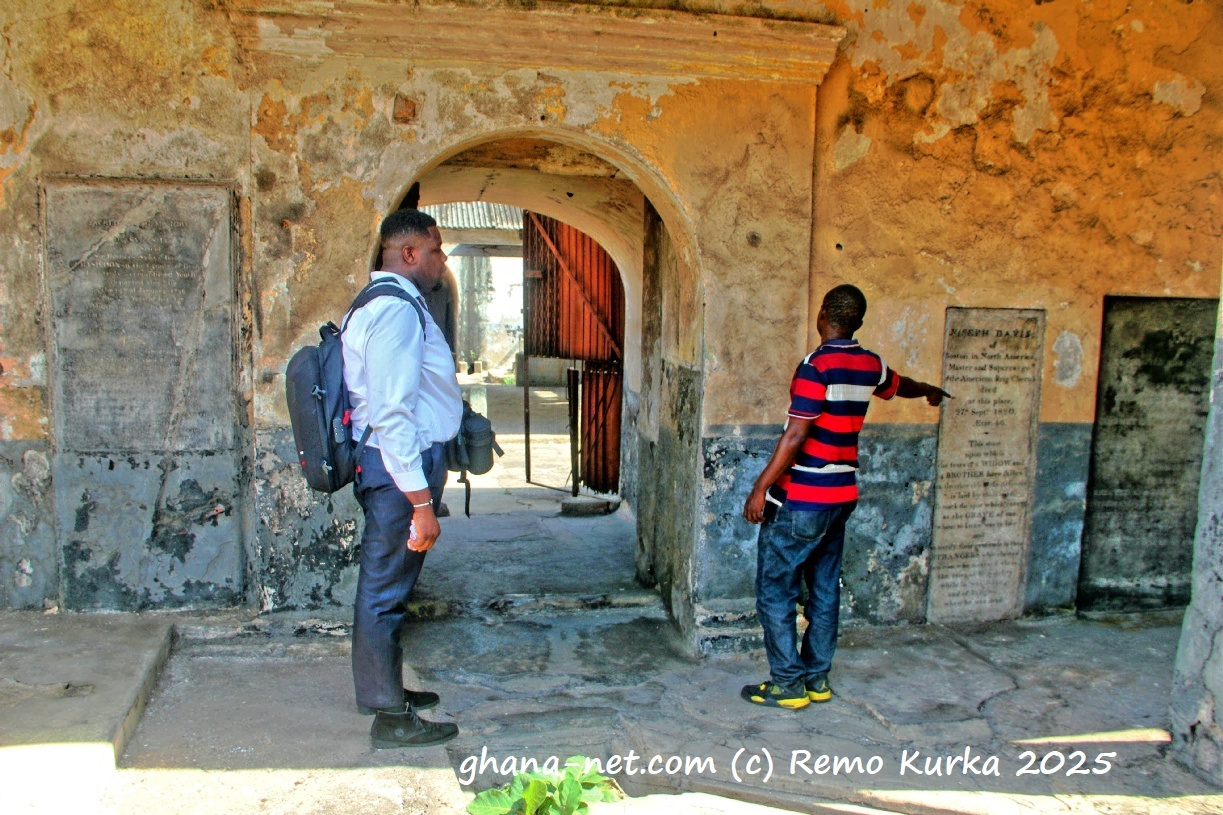But within a year, Francis succumbed to the harsh realities of the tropics—likely malaria or dysentery, diseases that claimed countless newcomers. His epitaph praises his innocence, sincerity, and friendship, describing him as “void of art,” meaning free of deceit. Buried hastily within the fort, his slab was raised by grieving comrades who saw in him a rare purity amid the brutal slave trade.
Francis’s grave symbolizes the peril of colonial ambition: a youth sent to learn commerce, but swallowed by fever in a land where trade meant chains and suffering.
⚓ Center Grave Plate: Joseph Davis (1820) – The Homesick Sailor
The central slab belongs to Joseph Davis, a 46‑year‑old mariner from Boston, USA, who died in 1820. As captain and supercargo of the Cherub, a fast brig of about 150 tons, Davis was responsible for negotiating deals with Ga traders for palm oil, ivory, and gold dust, while offloading New England goods.
Arriving at James Fort during a boom in “legitimate commerce” after the U.S. slave trade ban of 1807, Davis fell victim to fever epidemics that wiped out 20–30% of European crews. His epitaph thanks unnamed “strangers” for compassionate burial rites—perhaps local fishermen or fort guards who tended him in his final hours.
The stone bridges oceans: his widow and brother mourned in Boston, while strangers in Accra buried him with dignity. The inscription reads: “Whom to know was to love.” His grave reminds us that the Atlantic trade claimed lives on all sides—not only enslaved Africans, but also sailors chasing fortune.
⚓ Right Grave Plate: John Anderson (1801) – The Captain’s Fatal Fall
The rightmost slab tells the story of John Anderson, a 36‑year‑old commander of the Nabob, who died on December 2, 1801 in “Danish Accra” (Osu, under Danish control). His death was shockingly personal: “Durch einen unglücklichen Fall in den Händen seines besten Freundes”—“through an unfortunate fall in the hands of his best friend.”
Speculation abounds: a hunting accident, a drunken slip, or a scuffle gone wrong. His comrades buried him at James Fort, a neutral ground for Europeans, and inscribed his slab in German, reflecting the multicultural swirl of Accra’s ports. The Latin closing, “Requiescat in pace”—“May he rest in peace”—adds solemnity.
Anderson’s grave humanizes the traders: flawed men chasing fortunes, felled by irony rather than rebellion. It also highlights Accra’s forgotten Danish layer, when Christiansborg Castle’s cannons boomed nearby until 1850.
Three Slabs, Three Fates: Youth, Sailor, Commander
Together, these three graves form a triptych of colonial fragility:
Francis Sylvester Jr. (1786) – youthful dreamer cut short by fever.
Joseph Davis (1820) – seasoned sailor buried by strangers.
John Anderson (1801) – captain felled by a friend’s fatal hands.
They remind us that James Fort was not only a site of chains and commerce, but also of human stories—ambition, irony, and loss.
Why This Matters Today
These slabs are more than relics. They are rich heritage anchors for understanding Ghana’s colonial past:
James Fort graves in Jamestown, Accra
Forgotten colonial graves Ghana
Royal African Company history
Danish Osu Christiansborg Castle heritage
Boston sailors Gold Coast trade
By preserving and telling these stories, we reclaim history from erasure. The slabs endure as whispers of empire’s human cost, embedded in the walls of a fort that once shipped thousands into slavery.
